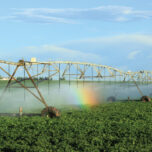But, he hastened to add, “the regional board isn’t going to tell farmers how to farm.” The board will set numbers for the level of water quality that growers must achieve and will assume that growers who use the practices identified by studies are doing the best they can to protect groundwater quality.
“Growers are free to use other techniques, but they’d have to demonstrate to the water board that their practices protect water quality,” says Karkoski.
Water quality monitoring and enforcement will also be key elements of the program.
Federal Action?
On the federal level, the Clean Water Act exemption for agricultural runoff has stood for 40 years and appears in no danger of being revoked — although in recent years EPA has instituted some narrow regulations governing large meat and dairy production operations.
The main federal program aimed at reducing nitrogen loads to surface waters is voluntary. For 27 years, the U.S. Department of Agriculture has run the Conservation Reserve Program, which pays farmers rent to idle or plant cover crops on environmentally sensitive land along water bodies. The goal is to avoid erosion and agricultural pollution to surface waters. However, in recent years, the corn ethanol boom has prompted some farmers to allow the contracts to lapse in favor of planting corn. And studies show that this voluntary program has had little effect on the size of the Dead Zone in the Gulf of Mexico.
For decades the EPA has acknowledged that nutrients are a serious threat to water quality.
In an attempt to prompt federal regulation to control nutrient pollution such as nitrogen and phosphorus in water, the Natural Resource Defense Council, working with a coalition of watershed groups along the Mississippi River, has undertaken a series of lawsuits over the past several years.
“The EPA and states have the obligation to look at what’s polluting their waters and are supposed to set numeric criteria for all of those pollutants to make sure the water remains healthy,” says Ann Alexander, a senior attorney for NRDC. If there were numeric targets for allowable nutrient pollution levels, states would be obligated to ensure that the targets are met and to identify contributing sources.
For decades the EPA has acknowledged that nutrients are a serious threat to water quality. But it has done nothing substantial to address the problem. So in 2008, the NRDC filed a petition asking the EPA to set numbers because states had not. After years of delay, the EPA finally responded, acknowledging again that nutrients are an important problem that needs to be addressed but failing to set numbers.
NRDC’s current lawsuit against the EPA contends that that response is legally deficient. The court will rule sometime after May 2013.
But, even if the NRDC wins, agriculture will still be exempt from getting permits for its runoff discharges under the Clean Water Act. For this reason, NRDC has spent considerable effort trying to get the EPA to enforce Clean Water Act regulations on point-source pollution, such as sewage treatment plants. Although they are a minority contributor to the nitrogen pollution, “You go after the part of the problem you can go after,” says Alexander.
The organization submitted another petition in 2007 to push the EPA to modernize sewage treatment plant requirements. The Clean Water Act requires the EPA to publish information about new technology available for secondary sewage treatment “from time to time.” It hasn’t done so since 1985. “‘Time to time’ is an imprecise term,” says Alexander, “but it’s got to mean something other than never.”
In December 2012, EPA responded the 2007 petition, saying that it would put out new secondary treatment information, but it wouldn’t address how such treatment can remove nutrients.
Cleaning Up
To meet drinking water standards in places where water supplies are polluted with nitrates, municipal drinking water facilities use technologies that have been approved by the EPA for cleaning the water. Reverse osmosis pushes water through a filter to clean it. Ion exchange swaps nitrate ions with benign ions. Electrodialysis uses electricity to push ions through a membrane. These processes filter out nitrates and concentrate them into a waste stream.
A new commercial technology, not yet approved by the EPA, aims to eliminate the waste stream. APTwater, based in Long Beach, Calif., grows autotrophic bacteria on the surface of the filter. The bacteria consume the nitrate, thus decomposing it.
Related Posts
Ensia shares solutions-focused stories free of charge through our online magazine and partner media. That means audiences around the world have ready access to stories that can — and do — help them shape a better future. If you value our work, please show your support today.
Yes, I'll support Ensia!



